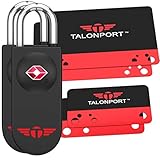Being able to lock up your luggage is super important, but not all locks are created equal. Sometimes you need tough security. Other times you need something simply to ensure you clothes don’t spill onto the airport luggage belt.
Having trouble deciding on the best luggage lock for your needs? Take a look at our handy guide to get a better grip on your options.
Built-In
Some pieces of luggage come with a built-in lock on the outside. These are more typically seen on briefcases, a la Pulp Fiction, but you can find larger suitcases with this option as well.
Built-in luggage locks almost always use a combination style, but other options (such as keys) can be found as well. Here’s a great option with a built-in combination lock:
Combo lock
ABS shell
Spinner wheels
One problem with built-in luggage locks as that since they’re often brand-specific, it can be a lot harder to find reviews and information on durability. With external luggage locks, it’s a lot easier to do your research and know the kind of quality you’re buying.
However, there’s a simple fix, though: use both types of luggage locks! One built in, one external.
An external TSA-approved luggage lock in addition to a built-in lock provides an extra layer of security for those concerned about the contents of their luggage. (Just make sure that your suitcase durability is good enough that a potential thief wouldn’t be able to bypass the lock by breaking the shell. Check out our comprehensive luggage material guide for more info on that.)
One very important note: If you’re planning on flying, you need to make sure your lock is TSA-approved. The TSA has universal keys that work on TSA-approved locks, allowing them to open them for security checks.
If you have a non-TSA lock on your luggage and your bag is selected for a search, the accessible lock will be forcibly removed. (And the TSA does not offer compensation for damaged or destroyed locks and luggage.)
Non Built-In
For most travelers, external locks are the way to go. Not only can you be more confident in the quality of the lock, but they’re more versatile too. When you’re not travelling, you can use them for lockers, home security, and more. And of course, if you’re flying, make sure your lock is TSA-approved so it doesn’t get destroyed.
Here are some common types of external locks.
Key
The old-fashioned lock and key. Ol’ reliable. Key locks are great for anyone who wants to ensure that only someone who holds that little piece of metal can crack open their stuff (excluding TSA agents, of course). If you’re neat and organized, this can be a great option.
Zinc alloy body
Intercompatible keys
4-pack
If you’re not so neat and organized, then a key lock can actually be a pretty big source of stress. If that little piece of metal slips out of your pocket on a flight or on the road, your next big purchase may be a pair of bolt cutters.
Here are a few other options that offer a little more freedom.
Card Key
Card key locks aren’t as popular as other options, but they can be a great choice if you would rather stick an extra card in your wallet instead of an extra key on your keychain. These cards usually use magnetic strips, RFID technology, or physical holes to open up the lock.
Solid metal body
Free card replacements
2-pack
Because card key locks aren’t as popular as other locks, it can be a little more difficult to find one with specifications that meet your needs. Luckily, the locks featured above come with multiple cards that work for each lock. And if you lose your cards, the manufacture will send a free replacement.
Dial/Combination
Dial or combination locks are the go-to these days. As long as you can remember 3 or 4 digits reliably, you don’t have to worry about losing your key. And you don’t have to stop at 3 or 4 digits; the more, the merrier!
If the lock features all ten integers, from 0 to 9, then each digit dial increases the odds of randomly guessing the combination by a factor of 10. So a 3-digit lock has a 1 in 1,000 chance of being randomly guessed, a 4-digit lock has a 1 in 10,000 chance of being randomly guessed, and so on.
If a person with questionable intentions and nimble fingers were able to try two combinations each second, it would take them over an hour and twenty minutes to try each possibility on a 4-digit lock. That jumps up to over two hours and forty-five minutes for a 5-digit lock! Memorizing a few extra digits can bring a lot of extra security, provided you don’t use an easy-to-guess combo like 00000 or 12345.
And just like with any other lock style, dial locks come in TSA-approved variations as well, featuring a little keyhole for those universal keys.
Password
Password combination locks are simply dial locks that use letters instead of numbers. If you have trouble remembering a string of digits like 8675309, then perhaps a lock that lets you set a combo like “NOFORGET” or something else witty will be easier to manage. Since it’s not easy to fit 26 character options into one ring, locks are often limited with regard to the letters you can select for each position. They can kind of feel like a game of Scrabble. Others have detachable rings that you can rearrange for more letter combination possibilities.
Unless you choose to use a random string of characters, password combination locks are marginally less secure than number combination locks. Whereas a four-digit number lock has 10,000 equally-likely combinations, a word lock will likely only have a few hundred real words that can be selected with a given set of letters for each position. It almost defeats the purpose of memorability, but if you opt for a combination like “JWQPCU” over “JUMPED”, your password combination lock will be a bit safer.
A Note on Cable vs. Bar Locks
Some luggage locks use a cable instead of a solid metal bar for the shackle (the U-shaped part). There are some pros and cons to this.
The cable’s primary purpose is to ensure that the lock can be attached to almost any kind of zipper slider, as long as the holes aren’t incredibly tiny. This is less secure because cables are easier to cut through than bars, but it ensures a bit more universality. If your luggage has larger holes on the zipper sliders, you may want to opt for the sturdiness of the solid bar lock.






